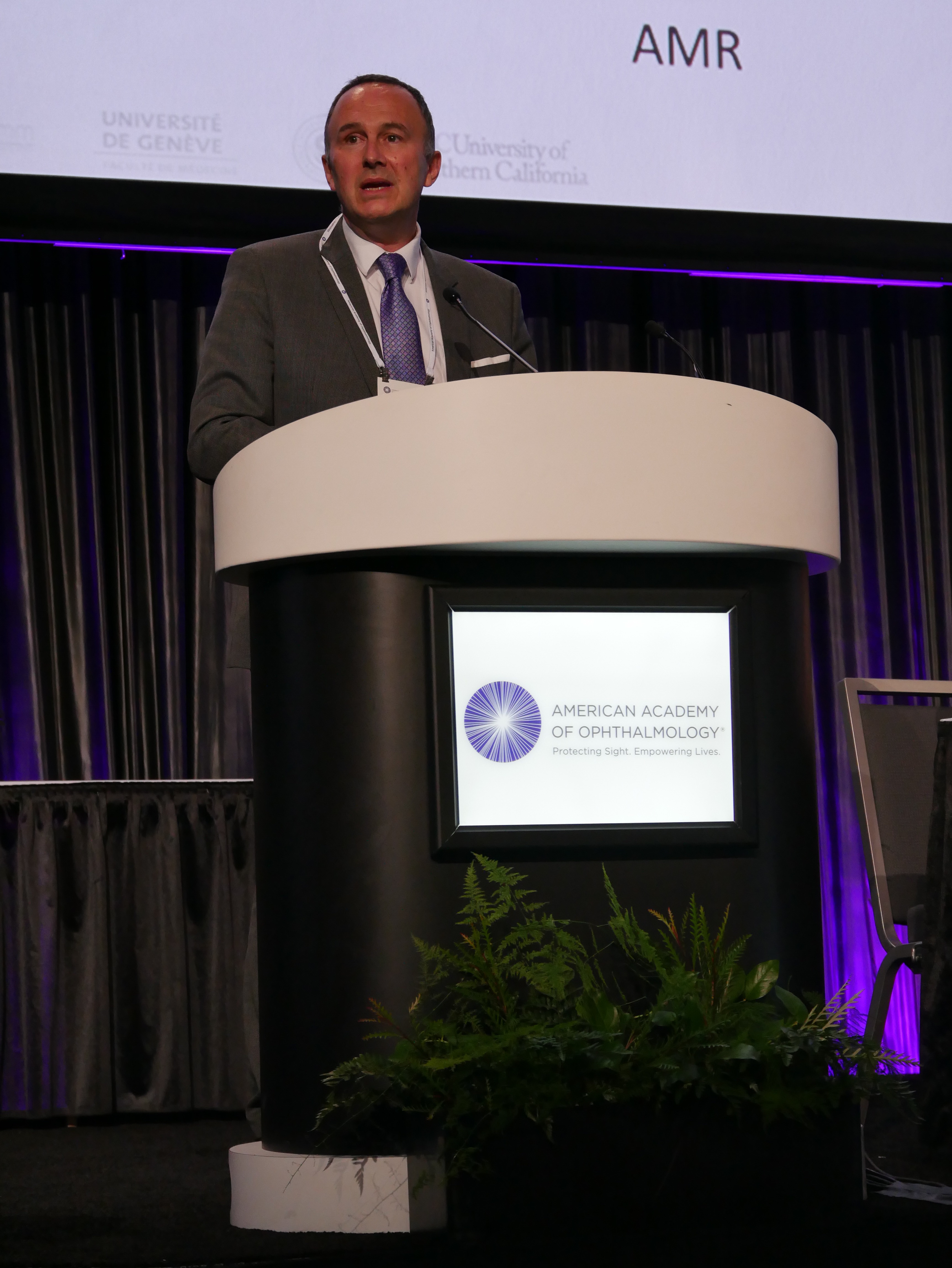Whitney G Sampson lecture at AAO conference
Prof. Farhad Hafezi, Medical Director of the ELZA Institute, Dietikon, and Research Group Leader at the Center of Applied Biotechnology and Molecular Medicine at the University of Zurich, had the honor of delivering the prestigious Whitney G Sampson lecture on Sunday, October 13th, 2019 at the annual conference of the American Academy of Ophthalmology (AAO) in San Francisco, California.

Prof. Farhad Hafezi was presented with the Whitney G Sampson Lecture award by the President of CLAO (The Contact Lens Association of Ophthalmologists) Dr. Michelle Rhee immediately after the Whitney G Sampson Lecture.
The title of the lecture, “Expanding CXL From Keratoconus to Infectious Keratitis”, certainly piqued the interest of conference delegates. Those who managed to find a seat in the packed auditorium were treated to an uplifting story of how the pathogen-killing treatment, now termed “photo-activated chromophores for keratitis-corneal cross-linking” (PACK-CXL) was developed.
The AAO delegates in San Francisco learned just how effective PACK-CXL is at treating bacterial, fungal and mixed bacterial/fungal infections: it appears that in most cases, a single PACK-CXL treatment can successfully treat these infections without the use of additional antibiotic or antifungal drugs.
The audience learned just how dangerous and fast-moving infectious keratitis can be. People can be blinded by infectious keratitis within one day, and given the millions of new cases every year, the World Health Organization calls it a “silent epidemic”. Delegates were reminded of how antimicrobial drug resistance is growing and the ever-increasing importance of techniques that can kill drug-resistant pathogens.
Those present in the room were shown the disparities in treatment availability in developed and developing countries and reminded that current clinical practice means that CXL and PACK-CXL are usually performed in an operating room (OR) – a location that is usually in hospitals and large population centers, a fact that is consistent whether the patient needing treatment lives in a developed or developing country.
The story of PACK-CXL ended on a more optimistic note. The future of PACK-CXL lies not in the OR, but at the slit lamp – an instrument that is ubiquitous in eyecare. Wherever there is an eye doctor, there is a slit lamp, and these are present everywhere from the most prestigious eye clinics in the world to makeshift clinics in tents in rural parts of the developing world. This was a story of bringing a new treatment to the world, that addresses a huge and growing problem, and how advances in technology and clinical practice is “democratizing” a once exclusive sight-saving procedure, thereby saving the sight of many more people in the future.
The Whitney G Sampson lecture, one of nine eponymous lectures at the annual conference is sponsored by the Contact Lens Association of Ophthalmologists (CLAO) and has its origins in the year of 1998 when Dr. Whitney G Sampson was honored for his outstanding contributions to ophthalmology with a lecture named after him.
For more information please visit:
Schweizer Augenarzt in San Francisco ausgezeichnet
Farhad Hafezi hält die "Whitney Sampson Lecture" der American Academy of Ophthalmology.
Mit 24’000 Teilnehmern aus 135 Ländern ist die American Academy of Ophthalmology (AAO) der weltweit grösste Kongress auf dem Gebiet der Augenheilkunde. Die AAO hielt ihren Jahreskongress vom 11. bis 15. Oktober 2019 in San Francisco ab.
Als Highlight des Programms werden die Named Lectures abgehalten. Insgesamt neun an der Zahl, steht jede Named Lecture für eine der neun Sub-Spezialisierungen innerhalb der Augenheilkunde
Prof. Farhad Hafezi, Augenchirurg am ELZA Institut Dietikon und Forschungsgruppenleiter am Labor für Zellbiologie des Auges der Universität Zürich gab auf dem Gebiet „Hornhaut“ die Whitney G Sampson Lecture mit dem Titel
“Expanding CXL From Keratoconus to Infectious Keratitis”
Das CXL (Cross-Linking der Hornhaut) ist eine Therapie, welche ursprünglich in Dresden und Zürich zur Behandlung des Keratokonus, einer Hornhaut-Degenerationen entwickelt wurde. Hafezi und Kollegen haben 2007 entdeckt, dass CXL auch hervorragend bei Infekten der Hornhaut wirkt. Die Lecture spannte einen Bogen über die Forschung von Hafezi’s Gruppe der letzten Jahre und zeigt auf, wie diese zukunftsträchtige Technologie auch bei schweren und antibiotikaresistente Infektionen der Hornhaut hilft.
Weitere Informationen finden sie unter:
American Academy of Ophthalmology - Programm Highlights
American Academy of Ophthalmology - Whitney G Sampson Lecture